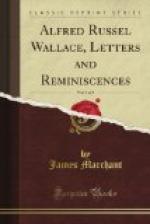The Malay Archipelago, in the unregenerated days when Wallace roamed the forests, and sailed the Straits in native boats and canoes, was full of danger to wanderers of the white race. Anarchy prevailed in many parts; usurping nobles enslaved the people in their houses; and piratical fleets scoured the sea, capturing and enslaving yearly thousands of peaceful traders, women and children. The writer was himself in 1862 besieged in a Bornean river by a pirate fleet, which was eventually destroyed by a Sarawak Government steamer with the following result of the fight: 190 pirates and 140 captives were killed or drowned, and 250 of the latter were liberated and sent to their homes; showing how formidable these pirates were. But Wallace, absorbed in his scientific pursuits, minded not these dangers, nor the hardships of any kind which a roving life in untrodden jungles and feverish swamps brings.
When Wallace left Sarawak after his fifteen months’ residence in the country, he left his young assistant, Charles Allen, there. He entered my service, and remained some time after the formation of the Borneo Company. Later, he again joined Wallace, and then went to New Guinea, doing valuable collecting and exploring work. He finally settled in Singapore, where I met him in 1899. He had married and was doing well; but died not long after my interview with him. He had come to the East with Wallace as a lad of 16, and had been his faithful companion and assistant during years of arduous work.—L.V.H.
The eight years spent by Wallace in this almost unknown part of the world were times of strenuous mental and physical exertion, resulting in the gathering together of an enormous amount of matter for future scientific investigation, but counterbalanced unfortunately by more or less continuous ill-health—which at times made the effort of clear reasoning and close application to scientific pursuits extremely difficult.
An indication of the unwearying application with which he went about his task is seen in the fact that during this period he collected 125,660 specimens of natural history, travelled about 14,000 miles within the Archipelago, and made sixty or seventy journeys, “each involving some preparation and loss of time,” so that “not more than six years were really occupied in collecting.”




